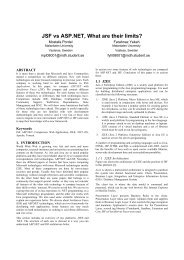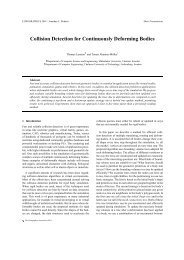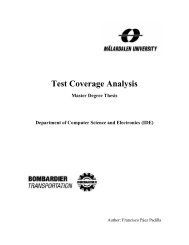Implementation of data collection tools using NetFlow for statistical ...
Implementation of data collection tools using NetFlow for statistical ...
Implementation of data collection tools using NetFlow for statistical ...
Create successful ePaper yourself
Turn your PDF publications into a flip-book with our unique Google optimized e-Paper software.
2 Theoretical background<br />
As derived from the example illustration above, traffic in is plotted as a full green area while traffic<br />
out is plotted as a blue line. It displays the maximum recorded value, average- and current value.<br />
[36]<br />
MRTG can be used in conjunction with RRDTOOL, a s<strong>of</strong>tware suite designed to log and analyze<br />
collected <strong>data</strong>. It does this by storing the <strong>data</strong> in a custom <strong>data</strong>base file that end in .rrd <strong>for</strong>mat. These<br />
files contain historical <strong>data</strong> over a definable time period. Using the RRDTOOL program, graphs can<br />
be generated from the <strong>data</strong>base. These graphs are pure image files, enabling them to easily be<br />
incorporated into web pages <strong>for</strong> viewing. [37]<br />
2.10pmacct<br />
pmacct is a network monitoring suite designed to run on Unix systems with the aim to classify,<br />
measure and export real-time traffic <strong>data</strong>.<br />
pmacct <strong>of</strong>fers finer granularity than <strong>using</strong> SNMP <strong>for</strong> collecting traffic in<strong>for</strong>mation, <strong>of</strong> which it is<br />
capable <strong>of</strong> getting from several sources including <strong>NetFlow</strong>, sFlow and IPFIX. It can then take this<br />
in<strong>for</strong>mation and tag it in order <strong>for</strong> it to be in line with the company policy or just a way <strong>of</strong><br />
distinguishing important traffic be<strong>for</strong>e exporting it. pmacct can export the <strong>data</strong> in many ways,<br />
including several different types <strong>of</strong> <strong>data</strong>bases, memory tables or even files on the hard drive.<br />
2.11 Baselining<br />
In order to distinguish potential harmful traffic from the ordinary day-to-day traffic throughout the<br />
network, a method <strong>of</strong> baselining can be implemented. Having a baseline <strong>of</strong> the traffic means to<br />
know how much traffic normally pass through and at what time during the day certain drops or<br />
spikes occur. A prime example <strong>of</strong> this would be seeing a drop in traffic during lunch hours when<br />
employees are away from their computers. There might be a cause <strong>for</strong> alarm if the drop doesn't<br />
occur when it should, or when any deviation from the norm is observed. Investigating the issue<br />
might show a high amount <strong>of</strong> connections <strong>of</strong> the same type to a specific IP address, which could<br />
indicate a potential DoS attack in progress.<br />
Likewise if an alarm goes <strong>of</strong>f indicating more than the usual number <strong>of</strong> open connections on a<br />
device, server or router, might indicate a SYN Flood-attack in progress.<br />
24

















